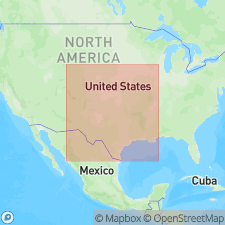
- Usage in publication:
-
- Argentine limestone
- Modifications:
-
- Overview
- AAPG geologic province:
-
- Forest City basin
Summary:
Correlation chart. Argentine limestone, new name [see Newell, 1935]. Underlies Island Creek shale and overlies [Type] Lane shale. Basal part of Lansing group redefined. Age is Late Pennsylvanian (Missouri age).
Source: US geologic names lexicon (USGS Bull. 896, p. 69); GNC KS-NE Pennsylvanian Corr. Chart, sheet 1, Oct. 1936.
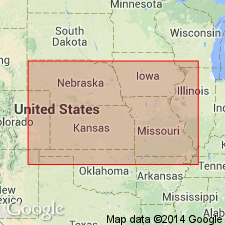
- Usage in publication:
-
- Argentine limestone member
- Modifications:
-
- Overview
- Dominant lithology:
-
- Limestone
- AAPG geologic province:
-
- Forest City basin
Summary:
Pg. 92, 97. Argentine limestone member of Wyandotte limestone of Lansing group. Age is Late Pennsylvanian (Missouri age). [See entry under Wyandotte limestone. Origin of name not stated. On p. 46 Argentine limestone is described as consisting of 10 to 32.5 feet of white, irregularly bedded limestone. On p. 92 Moore states that Argentine limestone replaces what had been called Iola limestone at Kansas City.]
Source: US geologic names lexicon (USGS Bull. 896, p. 69); GNC KS-NE Pennsylvanian Corr. Chart, sheet 2, Oct. 1936.
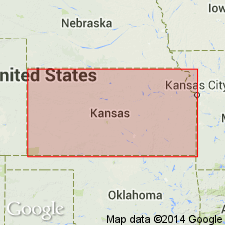
- Usage in publication:
-
- Argentine limestone member
- Modifications:
-
- Revised
Summary:
[Submitted Oct. 1932.] Wyandotte limestone is reassigned to the upper part of the Kansas City group in Kansas and Nebraska. Wyandotte limestone includes (descending) Farley limestone, Island Creek shale, Argentine limestone, Quindaro shale, and Frisbie limestone members. Underlies Bonner Springs shale, uppermost formation of Kansas City Group; overlies Lane shale of Kansas City group. Age is Pennsylvanian (Missourian [redefined]).
Source: GNC KS-NE Pennsylvanian Corr. Chart, sheet 2, Oct. 1936.
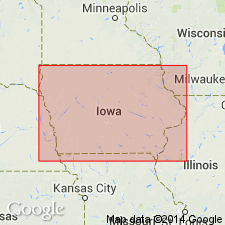
- Usage in publication:
-
- Argentine limestone
- Modifications:
-
- Not used
- AAPG geologic province:
-
- Forest City basin
Summary:
Pg. 11. Argentine limestone is the "Iola" at Kansas City, but according to Kansas geologists it is higher in section than Iola at type locality.
Source: US geologic names lexicon (USGS Bull. 896, p. 69).
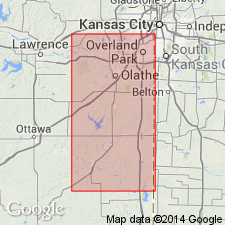
- Usage in publication:
-
- Argentine limestone member
- Modifications:
-
- Principal reference
- Dominant lithology:
-
- Limestone
- AAPG geologic province:
-
- Forest City basin
Summary:
Pg. 18, 59-60. Argentine limestone member of Wyandotte limestone of Kansas City group. Consists of 20 to 30 feet of light-gray, thin-bedded, wavy limestone, underlying Island Creek shale member and overlying Quindaro shale member. Comprises main part of so-called Iola limestone of Missouri and northeastern Kansas, which is younger than true Iola limestone. Age is Pennsylvanian. [Report includes cross section.]
Type exposure in a quarry south of 26th and Metropolitan Ave., [Kansas City, KS]. Named from Argentine railway station, Kansas City, KS.
Source: US geologic names lexicon (USGS Bull. 896, p. 69); GNC KS-NE Pennsylvanian Corr. Chart, sheet 2, Oct. 1936.
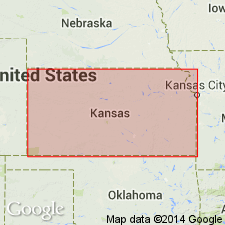
- Usage in publication:
-
- Argentine limestone member
- Modifications:
-
- Overview
- AAPG geologic province:
-
- Forest City basin
Summary:
Argentine limestone member of Wyandotte limestone of Kansas City group. R.C. Moore states that Newell is author of this name. Argentine limestone member is same as Iola limestone of Hinds and Greene (1915). Age is Late Pennsylvanian (Missouri age).
Source: US geologic names lexicon (USGS Bull. 896, p. 69); GNC KS-NE Pennsylvanian Corr. Chart, sheet 2, Oct. 1936.
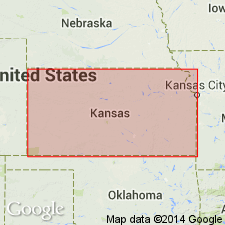
- Usage in publication:
-
- Argentine limestone member*
- Modifications:
-
- Areal extent
Summary:
Pg. 106 (fig. 20), 109-110. Argentine limestone member of Wyandotte formation. Mostly very fine grained light-bluish-gray limestone that weathers creamy white, grayish white, or light buff. Bedding thin and uneven; many layers distinctly nodular. Normally, thickest subdivision of Wyandotte formation. Average thickness 20 feet; 30 feet thick at Kansas City. Overlies Quindaro shale member; underlies Island Creek shale member, or, where this shale is absent, underlies Farley limestone member. Disappears south of Lane [Kansas] but is persistent northeastward in Missouri; identified in Iowa and southeastern Nebraska. Age is Late Pennsylvanian (Missourian).
Source: US geologic names lexicon (USGS Bull. 1200, p. 131).
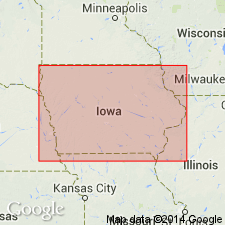
- Usage in publication:
-
- Argentine limestone member*
- Modifications:
-
- Areal extent
- AAPG geologic province:
-
- Iowa shelf
- Forest City basin
Summary:
Pg. 25, fig. 5. Argentine limestone member of Wyandotte formation. Argentine member in Madison County is 18-foot sequence of two or three massive limestones separated by dark-gray to buff calcareous shales. Fossiliferous throughout with OSAGIA and brachiopods. Thickness 12 feet in Union County. Overlies Quindaro shale member; underlies Island Creek shale member. Age is Late Pennsylvanian (Missourian).
Source: US geologic names lexicon (USGS Bull. 1200, p. 131).
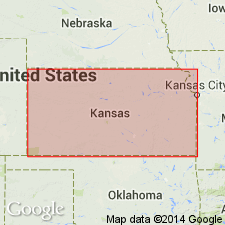
- Usage in publication:
-
- Argentine Limestone Member
- Modifications:
-
- Overview
Summary:
(Paleozoic Era; Pennsylvanian System by J.M Jewett, H.G. O'Connor, and D.E. Zeller, p. 32.) Argentine Limestone Member of Wyandotte Limestone of Zarah subgroup [informal] of Kansas City Group. In Kansas, a prominent escarpment-forming light bluish-gray, wavy-bedded limestone, much of which weathers very light-gray or yellowish-gray. Clay partings are numerous in some outcrops. Marine fossils are plentiful. Thickness ranges from 0 to 37 feet. Occurs above Quindaro Shale Member and below Island Creek Shale Member, both of Wyandotte Limestone. Age is Late Pennsylvanian (Missourian).
["Subgroup" not recognized as a formal stratigraphic rank term (CSN, 1933; ACSN, 1961, 1970; NACSN, 1983, 2005, 2021). Considered informal and should not be capitalized.]
Source: Publication.
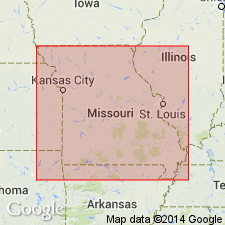
- Usage in publication:
-
- Argentine Limestone Member
- Modifications:
-
- Overview
- AAPG geologic province:
-
- Forest City basin
Summary:
Pg. 113 (fig. 34), 116. Argentine Limestone Member of Wyandotte Formation of Zarah subgroup [informal] of Kansas City Group. A fossiliferous limestone. Algal material is thought to be the most important constituent of the rock, although many invertebrate fossils also occur in it. Thickness decreases from a maximum of 40+ feet at Kansas City to less than 1 foot in northern Missouri. A thick limestone, in northwestern Cass County, that has long been referred to as the Argentine is now believed to include the Farley as well. Overlies Quindaro Shale Member and underlies Island Creek Shale Member, both of Wyandotte Formation. Age is Late Pennsylvanian (Missourian).
["Subgroup" not recognized as a formal stratigraphic rank term (CSN, 1933; ACSN, 1961, 1970; NACSN, 1983, 2005, 2021). Considered informal and should not be capitalized.]
Source: Publication.
For more information, please contact Nancy Stamm, Geologic Names Committee Secretary.
Asterisk (*) indicates published by U.S. Geological Survey authors.
"No current usage" (†) implies that a name has been abandoned or has fallen into disuse. Former usage and, if known, replacement name given in parentheses ( ).
Slash (/) indicates name conflicts with nomenclatural guidelines (CSN, 1933; ACSN, 1961, 1970; NACSN, 1983, 2005, 2021). May be explained within brackets ([ ]).

